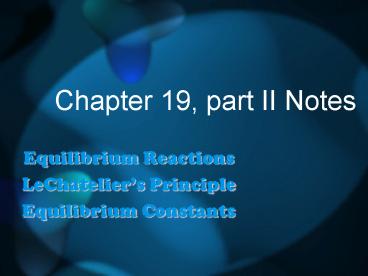Chapter 19, part II Notes - PowerPoint PPT Presentation
1 / 24
Title:
Chapter 19, part II Notes
Description:
Chapter 19, part II Notes Equilibrium Reactions LeChatelier s Principle Equilibrium Constants Reactions so far Up to now, we have assumed that reactions go one ... – PowerPoint PPT presentation
Number of Views:97
Avg rating:3.0/5.0
Title: Chapter 19, part II Notes
1
Chapter 19, part II Notes
- Equilibrium Reactions
- LeChateliers Principle
- Equilibrium Constants
2
Reactions so far
- Up to now, we have assumed that reactions go one
way and stop when all reactants have become
products. - This is true sometimes, but not always. There
are also
3
Reversible Reactions
- In a reversible reaction, the reaction occurs
simultaneously in both directions. - Products are being formed and are also being used
to form reactants.
4
- 2SO2 O2 D 2SO3
5
Equilibrium
- So how much product is formed? It depends on the
reaction. - Eventually, the reaction will reach chemical
equilibrium, where forward and reverse reactions
take place at the same rate.
6
Equilibrium
- This does NOT mean that the amounts of product
and reactant are the same. - The equilibrium position is the relative percent
of products and reactants in a system at
equilibrium.
7
8
LeChateliers Principle
- Henri LeChatelier studied shifts in the
equilibrium of reactions and came up with his
principle. He said - If a stress is applied to a system in dynamic
equilibrium, the system changes to relieve the
stress.
9
LeChateliers Principle
- Lets look at how several factors will shift the
equilibrium point.
10
Concentration
- Increasing the concentration of a product or
reactant in equilibrium will shift the
equilibrium point away from that substance. - Decreasing the concentration would have the
opposite effect.
11
H2CO3 D H2O CO2
- Which way will equilibrium shift if adding
- CO2
- H2CO3
- H2O
- Which way will equilibrium shift if removing
- CO2
- H2CO3
12
Temperature
- Adding heat to a reaction at equilibrium will
shift the equilibrium point towards the side that
absorbs heat. - Removing heat will shift the equilibrium point
towards the side that produces heat.
13
2SO2 O2 D 2SO3 heat
- Which way will equilibrium shift if heat is
added? - Which way will it shift if heat is removed?
14
Pressure
- Adding pressure to a system at equilibrium will
shift the equilibrium point towards the side that
has the least moles of gas. - Decreasing pressure shifts equilibrium towards
the side with the most moles of gas.
15
N2 3H2 D 2NH3
- Assuming all the products and reactants are
gases, which way does equilibrium shift when
pressure is added? - Which way does it shift when pressure is relieved?
16
(No Transcript)
17
Equilibrium Constants
- Generally, the equilibrium point is expressed as
a numerical value, called the equilibrium
constant, for any reversible reaction at a given
temperature.
18
Given the equation of a general reaction to be
coefficients
- aA bB D cC dD
19
The equilibrium constant would be
CcDd AaBb
- Keq
The brackets around the substances means it is
their concentration (molarity).
20
Equilibrium constant
- If the equilibrium constant (Keq) is bigger than
one, it means the products are favored at
equilibrium. - A Keq less than one means the formation of
reactants is favored at equilibrium.
21
(No Transcript)
22
N2O4 D 2NO2
- In the above reaction, at the equilibrium point,
dinitrogen tetroxide has a concentration of
0.0045M and nitrogen dioxide has a concentration
of 0.030M. What is the equilibrium constant for
the reaction?
23
N2 3H2 D 2NH3
- Calculate Keq for the reaction if at equilibrium
in 1.0L there is 0.15mol H2, 0.25mol N2 and
0.10mol NH3.
24
2HI D H2 I2
- Keq for the above reaction is 0.020 if the
concentration of hydrogen and iodine are both
0.50M, what is the concentration of HI?































